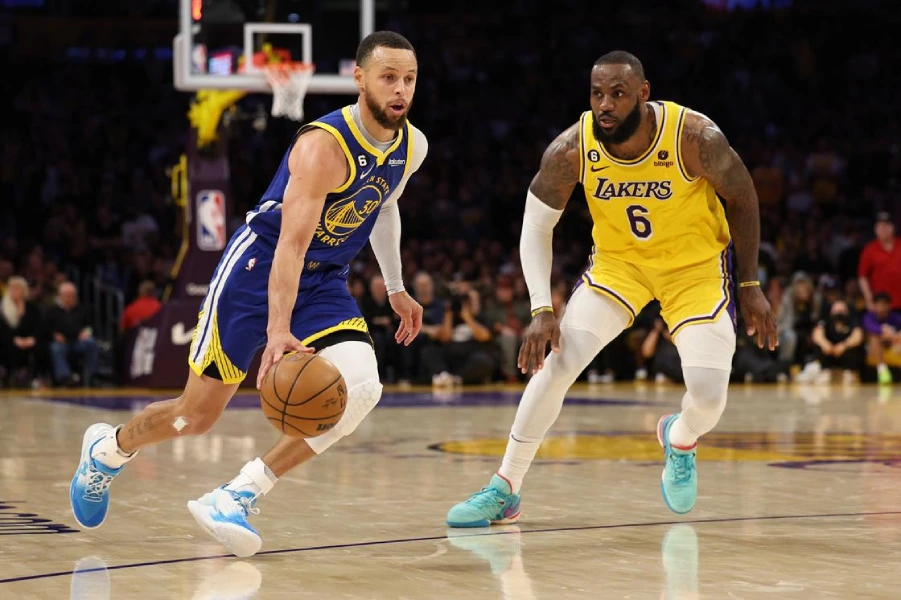
Did you know that the NBA players play 82 games a season? That indicates they gave it their all 82 times, slicing, twisting, jabbing, and coasting.
You have probably witnessed a basketball player wearing a knee brace, whether you are seated courtside or on the couch. Actually, it’s uncommon to see a basketball player without one. So, exactly what kind of knee pads do NBA players wear?
What Are Knee Pads In Basketball?
Knee pads are protective equipment used by basketball players to help them avoid injuries while playing. They are constructed from sturdy, cushioned material, and because they are lightweight, their performance is unaffected.
Knee pads are available in various designs and dimensions; some even include extra features like adjustable straps for a more personalized fit or moisture-wicking technology. On and off the court, basketball is a high-fashion sport, and businesses are producing knee pads that complement the players and the sport’s aesthetic.

Although useful, a knee pad only provides half the defense against knee injury. However, knee pads incorporating integrated bracing or compression systems can avoid slight injuries or knee tears.
Why Do NBA Players Have To Wear Knee Pads?
Wearing knee pads while playing basketball will help you avoid injuries, support your knee, and control your pain. And here are details for the reasons mentioned:
Preventing Injuries
Basketball players frequently jump off the court, change direction quickly, and collide with other players. One of the most frequent injuries in basketball is to the knee, which can keep a player out of action for up to a year.
Knee pads are cushioned, absorbing impact and lowering the possibility of abrasions, bruises, and contusions. Moreover, the best basketball knee pads will guard against injuries caused by bumping against other players or making contact with the ground when diving for a ball.
Wearing knee pads during basketball games can lower the incidence of arthritis and persistent knee pain over time. Knee pads lessen the force these motions have on the knee, which can assist in avoiding chronic knee discomfort from ongoing strain on the joint.

Supporting The Knee
Knee damage is common among athletes, especially basketball players, who require the best knee support.
Certain knee pads have integrated compression material to support the entire knee region. Basketball players who regularly sprint, leap, and move laterally will find this useful.
Knee pads provide compression, which can lessen muscle discomfort and weariness. This assistance allows players to play at their best for extended periods of time, lowering their risk of fatigue-related ailments.
Pain Management
Injuries can harm the ligaments, tendons, and cartilage in the knee joint, leading to persistent discomfort, inflammation, and instability. Basketball players who are already experiencing knee pain may benefit from knee pads that have compression materials integrated into them. Certain knee protectors support even the patella or knee cap. The joint is kept in alignment, and the pain is reduced by the entire support.
These knee pads provide support, guard against new injuries, and shorten the healing period following prior injuries. The long-term health advantages of purchasing basketball gear like knee protectors make the cost minimal.
What Kind Of Knee Pads Do NBA Players Wear?
Numerous varieties of knee pads exist, each with special characteristics and advantages. In other sports, knee protectors come in even more varieties. Basketball knee pads come in a variety of forms, including:
Support Sleeves
Support sleeves are knee pads that press against the knee’s surrounding tissue to relieve mild knee pain.

Many athletes who use compression sleeves think their knees communicate with their brains, boosting their confidence and enabling them to perform at a higher level. While the knee cap is covered in certain compression braces, these are made expressly to support the entire knee, not just the knee cap.
From a scientific perspective, support sleeves enhance blood circulation to the surrounding muscles and tissues of the knee. In addition to keeping the muscles warm, blood flow helps to avoid ligament strains.
Padded Pull-On Knee Pad
Basketball players can safeguard their knees with the most practical knee pads—padded pull-on models. It is perfect for gamers looking for a comfy and lightweight choice.
Ethylene-vinyl acetate (EVA), a thermoplastic most recognized as the thick, white padding found in shoe soles, is typically used to make the pad. The knee pads are flexible for a range of motion and simple to put on and take off. Thanks to their various sizes, players can select their own personal preferences for comfort and style.
Knee Brace
A knee brace can improve stability all around. They are not just sleeves.
There are several varieties, forms, and sizes of knee braces. Usually composed of metal or hard plastic, they have knee and leg-encircling belts and cushions.
Knee braces ease joint pressure while providing support for the knee. Some even include support for the kneecap or patella. This support maintains the alignment of the joint and reduces pain. A basketball player may feel more confident playing aggressively after wearing a knee support brace.
Cons Of Wearing Knee Pads
Knee protection is crucial in basketball. When using knee pads, there are only a few things to watch out for.
Long-term use of knee pads can result in compression marks behind the knee and on the knee caps. Wearing them for an extended time can easily result in poor local blood circulation, insufficient blood flow, and a loss of muscle strength.
Furthermore, they will cause the muscles surrounding the knee joint to atrophy and become much weaker, which is not good for the joint’s stability. Therefore, knee pads can only be used temporarily rather than continuously.

Conclusion
Now that you’ve answered the question of what kind of knee pads do NBA players wear, you can see why knee pads are so crucial. They are an excellent knee protection tool to avoid common basketball-related knee injuries. If you prepare correctly by training and maintaining your fitness and flexibility, your leg muscles and a knee pad will be your strongest line of defense against knee injury.
